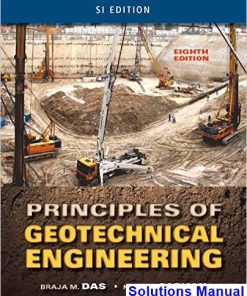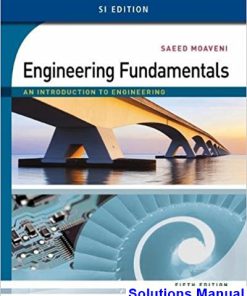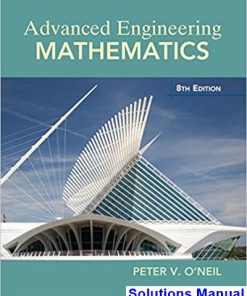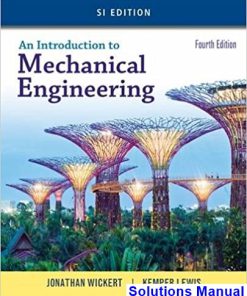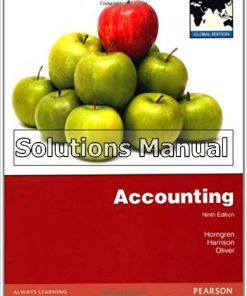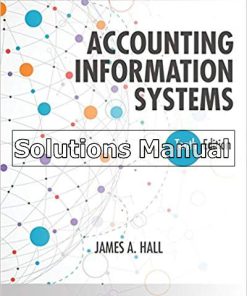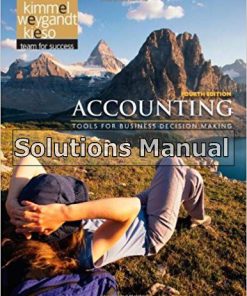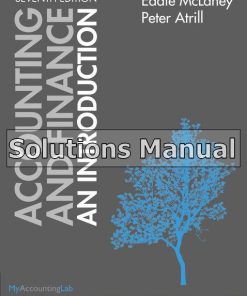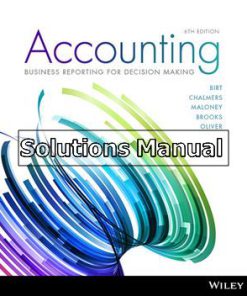Advanced Engineering Mathematics SI Edition 8th Edition ONeil Solutions Manual
$26.50$50.00 (-47%)
Advanced Engineering Mathematics SI Edition 8th Edition ONeil Solutions Manual.
You may also like
Advanced Engineering Mathematics SI Edition 8th Edition ONeil Solutions Manual
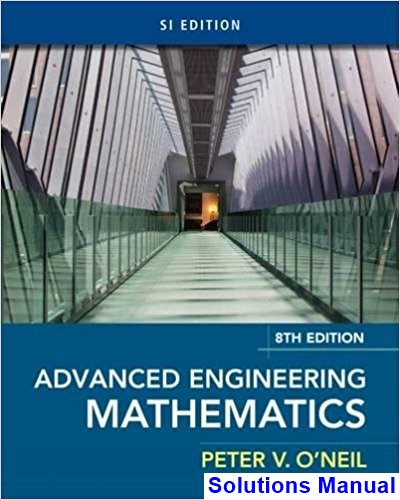
Product details:
- ISBN-10 : 1337274526
- ISBN-13 : 978-1337274524
- Author: Peter O’Neil (Author)
ADVANCED ENGINEERING MATHEMATICS, 8E is written specifically for students like you, who are primarily interested in how to effectively apply mathematical techniques to solve advanced engineering problems. Numerous examples include illustrations of mathematical techniques as well as applications. A “Math in Context” feature clearly demonstrates how the mathematical concepts and methods you are learning relate to current engineering problems. The book is organized into seven distinctive parts to provide precise focus on the individual mathematical ideas and methods. A student solutions manual offers detailed solutions to half of the problems in the book for your use in checking your progress as well as study and review.
Table contents:
Part 1: Ordinary Differential Equations
Chapter 1: First-Order Differential Equations
1.1 Terminology and Separable Equations
1.1.1 Singular Solutions
1.1.2 Some Applications of Separable Equations
Problems
1.2 The Linear First-Order Equation
Problems
1.3 Exact Equations
Problems
1.4 Homogeneous, Bernoulli, and Riccati Equations
1.4.1 The Homogeneous Differential Equation
1.4.2 The Bernoulli Equation
1.4.3 The Riccati Equation
Problems
Chapter 2: Second-Order Differential Equations
2.1 The Linear Second-Order Equation
Problems
2.2 The Constant Coefficient Homogeneous Equation
Problems
2.3 Particular Solutions of the Nonhomogeneous Equation
2.3.1 The Method of Variation of Parameters
2.3.2 The Method of Undetermined Coefficients
Problems
2.4 The Euler Differential Equation
Problems
2.5 Series Solutions
2.5.1 Power Series Solutions
Problems
2.5.2 Frobenius Solutions
Problems
Chapter 3: The Laplace Transform
3.1 Definition and Notation
Problems
3.2 Solution of Initial Value Problems
Problems
3.3 The Heaviside Function and Shifting Theorems
3.3.1 The First Shifting Theorem
3.3.2 The Heaviside Function, Pulses, and the Second Shifting Theorem
3.3.3 Heaviside’s Formula
Problems
3.4 Convolution
Problems
3.5 Impulses and the Dirac Delta Function
Problems
3.6 Systems of Linear Differential Equations
Problems
Chapter 4: Sturm-Liouville Problems and Eigenfunction Expansions
4.1 Eigenvalues, Eigenfunctions and Sturm-Liouville Problems
Problems
4.2 Eigenfunction Expansions
4.2.1 Properties of the Coefficients
Problems
4.3 Fourier Series
4.3.1 Fourier Series on [–L,L
4.3.2 Fourier Cosine Series on [0,L
4.3.3 Fourier Sine Series on [0,L
Problems
Part 2: Partial Differential Equations
Chapter 5: The Heat Equation
5.1 Diffusion Problems in a BoundedMedium
5.1.1 Ends Kept at Zero Temperature
5.1.2 Insulated Ends
5.1.3 One Radiating End
5.1.4 Nonhomogeneous Boundary Conditions
5.1.5 Inclusion of Convection and Other Effects
Problems
5.2 The Heat EquationWith a Forcing Term F(x,t)
Problems
5.3 The Heat Equation on the Real Line
5.3.1 A Reformulation of the Solution on the Line
Problems
5.4 The Heat Equation on a Half-Line
5.4.1 The Controversy Over the Age of the Earth
Problems
5.5 The Two-Dimensional Heat Equation
Problems
Chapter 6: The Wave Equation
6.1 Wave Motion on a Bounded Interval
6.1.1 Effect of c on the Motion
6.1.2 Wave MotionWith a Forcing Term F(x
Problems
6.2 Wave Motion in an UnboundedMedium
6.2.1 TheWave Equation on the Real Line
6.2.2 TheWave Equation on a Half-Line
Problems
6.3 d’Alembert’s Solution and Characteristics
Problems
6.4 TheWave EquationWith a Forcing Term K(x,t)
Problems
6.5 TheWave Equation in Higher Dimensions
Problems
Chapter 7: Laplace’s Equation
7.1 The Dirichlet Problem for a Rectangle
Problems
7.2 Dirichlet Problem for a Disk
Problems
7.3 The Poisson Integral Formula
Problems
7.4 The Dirichlet Problem for Unbounded Regions
Problems
7.5 A Dirichlet Problem in 3 Dimensions
Problems
7.6 The Neumann Problem
7.6.1 The Neumann Problem for a Rectangle
7.6.2 A Neumann Problem for a Disk
7.6.3 A Neumann Problem for the Upper Half-Plane
Problems
7.7 Poisson’s Equation
Problems
Chapter 8: Special Functions and Applications
8.1 Legendre Polynomials
8.1.1 A Generating Function
8.1.2 A Recurrence Relation
8.1.3 Rodrigues’s Formula
8.1.4 Fourier-Legendre Expansions
8.1.5 Zeros of Legendre Polynomials
8.1.6 Distribution of Charged Particles
8.1.7 Steady-State Temperature in a Sphere
Problems
8.2 Bessel Functions
8.2.1 A Generating Function for Jn(x
8.2.2 Recurrence Relations
8.2.3 Zeros of J. (x
8.2.4 Fourier-Bessel Eigenfunction Expansions
Problems
8.3 Some Applications of Bessel Functions
8.3.1 Vibrations of a Circular Membrane
8.3.2 Diffusion in an Infinite Cylinder
8.3.3 Oscillations in a Hanging Cord
8.3.4 Critical Length of a Rod
Problems
Chapter 9: Transform Methods of Solution
9.1 Laplace TransformMethods
9.1.1 ForcedWave Motion on a Half-Line
9.1.2 Temperature Distribution in a Semi-Infinite Bar
9.1.3 A Semi-Infinite Bar With Discontinuous Temperature at One End
9.1.4 Vibrations in an Elastic Bar
Problems
9.2 Fourier Transform Methods
9.2.1 The Heat Equation on the Real Line
9.2.2 The Dirichlet Problem for the Upper Half-Plane
Problems
9.3 Fourier Sine and Cosine Transform Methods
9.3.1 AWave Problem on the Half-Line
Problems
Part 3: Matrices and Linear Algebra
Chapter 10: Vectors and the Vector Space Rn
10.1 Vectors in the Plane and 3-Space
10.1.1 Equation of a Line in 3-Space
Problems
10.2 The Dot Product
10.2.1 Equation of a Plane
10.2.2 Projection of One Vector onto Another
Problems
10.3 The Cross Product
Problems
10.4 n-Vectors and the Algebraic Structure of Rn
Problems
10.5 Orthogonal Sets and Orthogonalization
Problems
10.6 Orthogonal Complements and Projections
Problems
Chapter 11: Matrices, Determinants, and Linear Systems
11.1 Matrices and Matrix Algebra
11.1.1 Terminology and Special Matrices
11.1.2 A Different Perspective of Matrix Multiplication
11.1.3 An Application to RandomWalks in Crystals
Problems
11.2 Row Operations and Reduced Matrices
Problems
11.3 Solution of Homogeneous Linear Systems
Problems
11.4 Solution of Nonhomogeneous Linear Systems
Problems
11.5 Matrix Inverses
Problems
11.6 Determinants
11.6.1 Evaluation by Row and Column Operations
Problems
11.7 Cramer’s Rule
Problems
11.8 The Matrix Tree Theorem
Problems
Chapter 12: Eigenvalues, Diagonalization, and Special Matrices
12.1 Eigenvalues and Eigenvectors
12.1.1 Linear Independence of Eigenvectors
12.1.2 Gerschgorin Circles
Problems
12.2 Diagonalization
Problems
12.3 Special Matrices and Their Eigenvalues and Eigenvectors
12.3.1 Symmetric Matrices
12.3.2 Orthogonal Matrices
12.3.3 Unitary Matrices
12.3.4 Hermitian and Skew-Hermitian Matrices
Problems
12.4 Quadratic Forms
Problems
Part 4: Systems Differential Equations
Chapter 13: Systems of Linear Differential Equations
13.1 Linear Systems
13.1.1 The Structure of Solutions of X’ = AX
13.1.2 The Structure of Solutions of X’ = AX + G
Problems
13.2 Solution of X’ = AXWhen A Is Constant
13.2.1 The Complex Eigenvalue Case
Problems
13.3 ExponentialMatrix Solutions
Problems
13.4 Solution of X’ = AX + G for Constant A
13.4.1 Variation of Parameters
Problems
13.4.2 Solutions by Diagonalization
Problems
Chapter 14: Nonlinear Systems and Qualitative Analysis
14.1 Nonlinear Systems and Phase Portraits
14.1.1 Phase Portraits of Homogeneous Linear Systems
Problems
14.2 Critical Points and Stability
Problems
14.3 Almost-Linear Systems
Problems
14.4 Linearization
Problems
Part 5: Vector Analysis
Chapter 15: Vector Differential Calculus
15.1 Vector Functions of One Variable
Problems
15.2 Velocity, Acceleration, and Curvature
Problems
15.3 The Gradient Field
15.3.1 Level Surfaces, Tangent Planes, and Normal Lines
Problems
15.4 Divergence and Curl
15.4.1 A Physical Interpretation of Divergence
15.4.2 A Physical Interpretation of Curl
Problems
15.5 Streamlines of a Vector Field
Problems
Chapter 16: Vector Integral Calculus
16.1 Line Integrals
16.1.1 Line Integrals with Respect to Arc Length
Problems
16.2 Green’s Theorem
16.2.1 An Extension of Green’s Theorem
Problems
16.3 Independence of Path and Potential Theory
Problems
16.4 Surface Integrals
16.4.1 Normal Vector to a Surface
16.4.2 The Surface Integral of a Scalar Field
Problems
16.5 Applications of Surface Integrals
16.5.1 Surface Area
16.5.2 Mass and Center of Mass of a Shell
16.5.3 Flux of a Fluid Across a Surface
Problems
16.6 Gauss’s Divergence Theorem
16.6.1 Archimedes’s Principle
16.6.2 The Heat Equation
Problems
16.7 Stokes’s Theorem
16.7.1 Potential Theory in 3-Space
Problems
Part 6: Fourier Analysis
Chapter 17: Fourier Series
17.1 Fourier Series on [–L, L]
17.1.1 Fourier Series of Even and Odd Functions
17.1.2 The Gibbs Phenomenon
Problems
17.2 Sine and Cosine Series
Problems
17.3 Integration and Differentiation of Fourier Series
Problems
17.4 Properties of Fourier Coefficients
17.4.1 Least-Squares Optimization
Problems
17.5 Phase Angle Form
Problems
17.6 Complex Fourier Series
Problems
17.7 Filtering of Signals
Problems
Chapter 18: Fourier Transforms
18.1 The Fourier Transform
18.1.1 Filtering and the Dirac Delta Function
18.1.2 TheWindowed Fourier Transform
18.1.3 The Shannon Sampling Theorem
18.1.4 Low-Pass and Bandpass Filters
Problems
18.2 Fourier Cosine and Sine Transforms
Problems
Part 7: Complex Functions
Chapter 19: Complex Numbers and Functions
19.1 Geometry and Arithmetic of Complex Numbers
19.1.1 Complex Numbers
19.1.2 The Complex Plane, Magnitudes, Conjugates, and Polar Form
19.1.3 Ordering of Complex Numbers
19.1.4 Inequalities
19.1.5 Disks, Open Sets, and Closed Sets
Problems
19.2 Complex Functions
19.2.1 Limits, Continuity, and Differentiability
19.2.2 The Cauchy-Riemann Equations
Problems
19.3 The Exponential and Trigonometric Functions
19.3.1 The Exponential Function
19.3.2 The Cosine and Sine Functions
Problems
19.4 The Complex Logarithm
Problems
19.5 Powers
19.5.1 nth Roots
19.5.2 Rational Powers
19.5.3 Powers zw
Problems
Chapter 20: Integration
20.1 The Integral of a Complex Function
Problems
20.2 Cauchy’s Theorem
Problems
20.3 Consequences of Cauchy’s Theorem
20.3.1 Independence of Path
20.3.2 The Deformation Theorem
20.3.3 Cauchy’s Integral Formula
20.3.4 Properties of Harmonic Functions
20.3.5 Bounds on Derivatives
20.3.6 An Extended Deformation Theorem
Problems
Chapter 21: Series Representations of Functions
21.1 Power Series
21.1.1 Antiderivatives of Differentiable Functions
21.1.2 Zeros of Functions
Problems
21.2 The Laurent Expansion
Problems
Chapter 22: Singularities and the Residue Theorem
22.1 Classification of Singularities
Problems
22.2 The Residue Theorem
Problems
22.3 Evaluation of Real Integrals
22.3.1 Rational Functions
22.3.2 Rational Functions Times a Cosine or Sine
22.3.3 Rational Functions of Cosine and Sine
Problems
Chapter 23: Conformal Mappings
23.1 The Idea of a Conformal Mapping
23.1.1 Bilinear Transformations
23.1.2 The Riemann Sphere
Problems
23.2 Construction of Conformal Mappings
23.2.1 The Schwarz-Christoffel Transformation
People also search:
Advanced Engineering Mathematics SI Edition 8th
finite mathematics 8th edition answers
advanced engineering mathematics 8e si edition solutions pdf
8th gen honda civic si for sale near me
k tuned exhaust 8th gen civic

